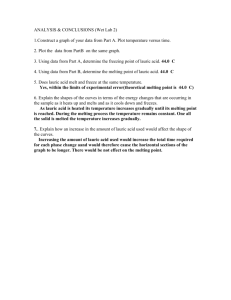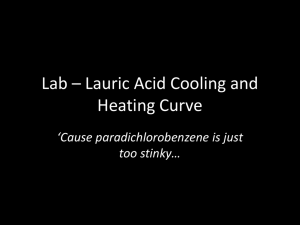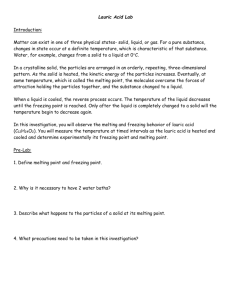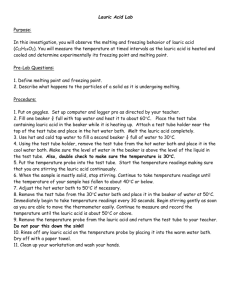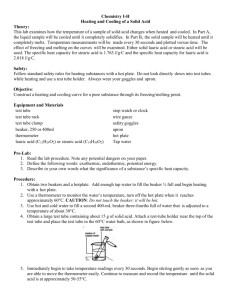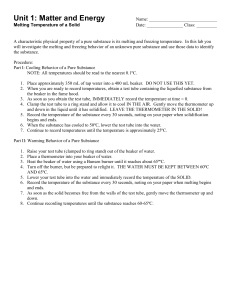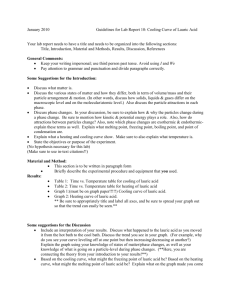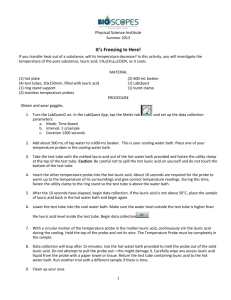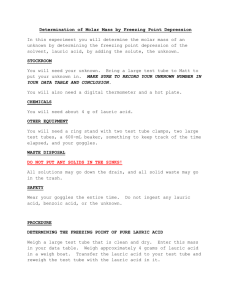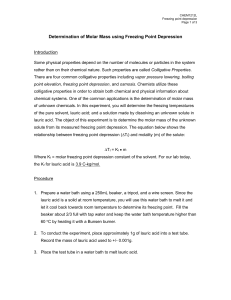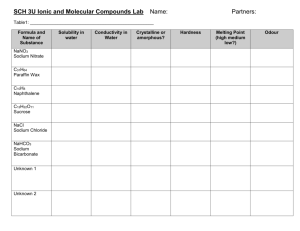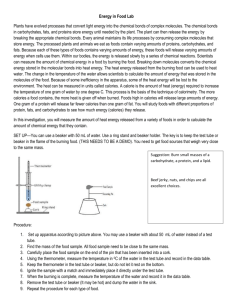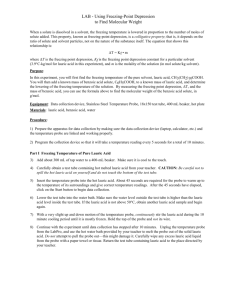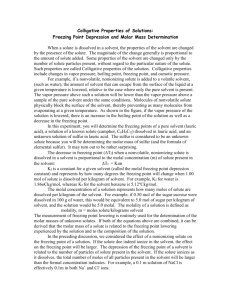Lauric Acid: Melting Point for a Substance
advertisement
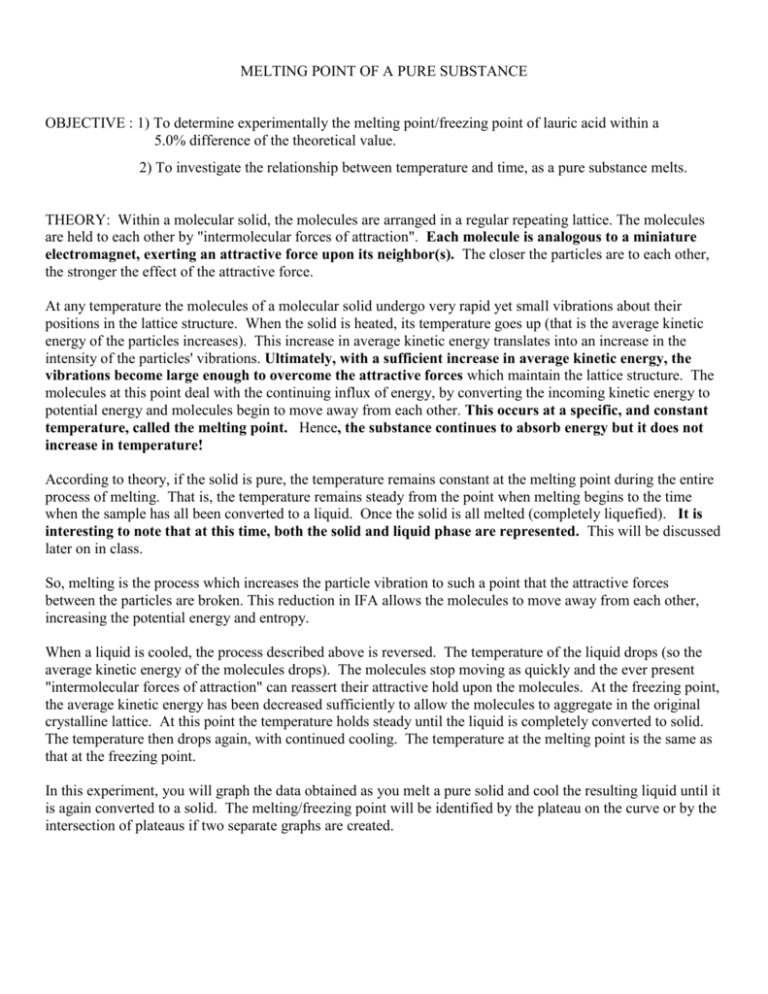
MELTING POINT OF A PURE SUBSTANCE OBJECTIVE : 1) To determine experimentally the melting point/freezing point of lauric acid within a 5.0% difference of the theoretical value. 2) To investigate the relationship between temperature and time, as a pure substance melts. THEORY: Within a molecular solid, the molecules are arranged in a regular repeating lattice. The molecules are held to each other by "intermolecular forces of attraction". Each molecule is analogous to a miniature electromagnet, exerting an attractive force upon its neighbor(s). The closer the particles are to each other, the stronger the effect of the attractive force. At any temperature the molecules of a molecular solid undergo very rapid yet small vibrations about their positions in the lattice structure. When the solid is heated, its temperature goes up (that is the average kinetic energy of the particles increases). This increase in average kinetic energy translates into an increase in the intensity of the particles' vibrations. Ultimately, with a sufficient increase in average kinetic energy, the vibrations become large enough to overcome the attractive forces which maintain the lattice structure. The molecules at this point deal with the continuing influx of energy, by converting the incoming kinetic energy to potential energy and molecules begin to move away from each other. This occurs at a specific, and constant temperature, called the melting point. Hence, the substance continues to absorb energy but it does not increase in temperature! According to theory, if the solid is pure, the temperature remains constant at the melting point during the entire process of melting. That is, the temperature remains steady from the point when melting begins to the time when the sample has all been converted to a liquid. Once the solid is all melted (completely liquefied). It is interesting to note that at this time, both the solid and liquid phase are represented. This will be discussed later on in class. So, melting is the process which increases the particle vibration to such a point that the attractive forces between the particles are broken. This reduction in IFA allows the molecules to move away from each other, increasing the potential energy and entropy. When a liquid is cooled, the process described above is reversed. The temperature of the liquid drops (so the average kinetic energy of the molecules drops). The molecules stop moving as quickly and the ever present "intermolecular forces of attraction" can reassert their attractive hold upon the molecules. At the freezing point, the average kinetic energy has been decreased sufficiently to allow the molecules to aggregate in the original crystalline lattice. At this point the temperature holds steady until the liquid is completely converted to solid. The temperature then drops again, with continued cooling. The temperature at the melting point is the same as that at the freezing point. In this experiment, you will graph the data obtained as you melt a pure solid and cool the resulting liquid until it is again converted to a solid. The melting/freezing point will be identified by the plateau on the curve or by the intersection of plateaus if two separate graphs are created. MATERIALS: Goggles, 1 test tube of lauric acid with a thermometer embedded in the lauric acid, 1 extra thermometer, 1 250 mL beaker, 1 ring stand, 1 ring clamp, 1 meeker burner or hot plate, and 1 test tube clamp. PROCEDURE: 1) Put on your goggles. 2) Clamp the test tube containing lauric acid and embedded thermometer, using the test tube clamp. 3) Adjust the 250 mL beaker and clamped test tube, so that you can estimate the amount of water needed so that the level of lauric acid in the clamped test tube is below the water line. Do not sit the test tube on the bottom of the beaker. If this can not be achieved using the 250 ml beaker, use a 400 ml beaker. 4) Once you know the approximate amount of water, add this amount to the 250 mL. Do not put the clamped test tub into the water….YET. CONTINUE TO READ THE PROCEDURE. 5) Using the 250 mL beaker with JUST WATER IN IT, set up a hot water bath, as you have been taught. 6) Heat the water to a temperature of 55.0 ˚C (Don't let the water's temp go above 55.0 ˚C). Use your extra (not-embedded) thermometer to indicate the temperature of the water bath. 7) Once the water bath is at 55.0 ˚C, turn off your meeker burner or hot plate. 8) Record the temperature, in ˚C, of the solid lauric acid at the "0" interval of your data sheet, by reading the temperature off of the embedded thermometer. Be sure you read the thermometer to 0.1 ˚C….(e.g. 21°C is unacceptable, 21.0°C or 21.2°C are acceptable exemplars) 9) NOW, INSERT THE CLAMPED TEST TUBE containing the lauric acid (be sure it's off the bottom of the beaker !!). 10) Record the temperature of the lauric acid at 15.0 second intervals until the embedded thermometer reads 75.0 ˚C. 11) Keeping the thermometer in the now liquid lauric acid , simply put the test tube and ALL OF ITS CONTENTS BACK IN THE BASKET FROM WHICH YOU OBTAINED IT. DO NOT: DISCARD, POUR OUT, GET RID OF, REMOVE, DRAIN OFF, DISPOSE OF, THROW OUT, TOSS or ELIMINATE the liquid lauric acid. DIAGRAM OF SET UP: EMBEDDED THERMOMETER TEST TUBE CLAMP BEAKER with WATER WATER LEVEL NOTE THAT THE BOTTOM OF THE TEST TUBE DOESNT TOUCH THE BOTTOM OF THE BEAKER SOLID ACID tip of inner blue flame GRAPHING: Please follow the basics of good graphing skills. I have included a list. Check it for full credit. Axes and labels are in pen The graph's data points and curves are in pencil The graph is titled appropriately The axes are designed so that at least 3/4 of a page of graph paper is used for the graph Intervals of each axis is internally equivalent The curve is a best fit curve If there are multiple curves on the graph, different colors are used and a legend is included. NAME ___________________________________________ LAB: MELTING POINT OF LAURIC ACID DATA TABLE: HEATING DATA FOR LAURIC ACID Heating Data Cooling Data Interval Temp ˚C Interval Temp ˚C 0 0 1 (15 s) 1 2 (30 s) 2 3 (45 s) 3 4 (60s) 4 5 5 6 6 7 7 8 8 9 9 10 10 11 11 12 12 13 13 14 14 15 15 16 16 17 17 18 18 19 19 20 20 21 21 22 22 23 23 24 24 25 25 26 26 27 27 28 28 29 29 30 30 31 31 32 32 33 33 34 34 35 35 36 36 37 37 38 38 39 39 40 40 41 41 42 42 43 43 44 44 45 45 46 46 47 47 GRAPH: Graph the collected data, using temperature as a function of time (intervals). Draw a "best fit curve" through the data points. CALCULATIONS: 1) Using the mode of your data as an experimental (measured) melting point, calculate the per cent error. The theoretical (accepted) value for the melting point of lauric acid is 48.0˚C. Use E.S.A. CONCLUSION : Always write a conclusion using full sentences. A conclusion should include (a) statement(s) : • as to whether the objective(s) was (were) attained. (For this lab, respond to both objectives). • which cites the theoretical value (e.g. melting point of lauric acid). • which cites your experimental value (your mode). • of your per cent error. • of any possible sources of human error. __________________________________________________________________________________________ __________________________________________________________________________________________ _________________________________________________________________________________________ _________________________________________________________________________________________ _________________________________________________________________________________________ __________________________________________________________________________________________ __________________________________________________________________________________________
